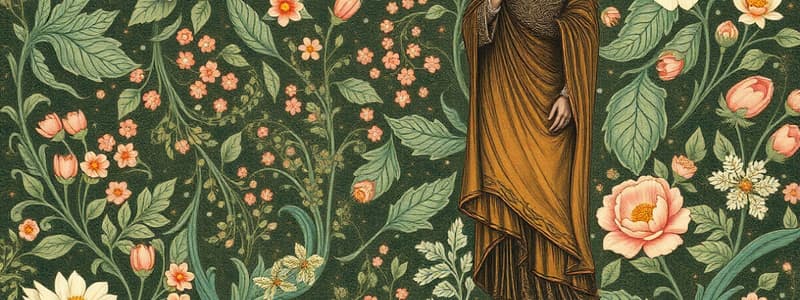Podcast
Questions and Answers
What metaphor does the speaker use to describe the acceptance of death in Sonnet 73?
What metaphor does the speaker use to describe the acceptance of death in Sonnet 73?
- A tree in autumn
- A dying fire (correct)
- A river flowing
- A setting sun
What significant change occurs in the mood of the poem towards the final couplet?
What significant change occurs in the mood of the poem towards the final couplet?
- It shifts from somber to brighter. (correct)
- It remains consistently melancholic.
- It oscillates between happiness and sadness.
- It shifts from hopeful to despairing.
Which theme emerges most clearly in the final couplet of Sonnet 73?
Which theme emerges most clearly in the final couplet of Sonnet 73?
- The dread of death and decay.
- The inevitability of nature's cycles.
- The regret of missed opportunities.
- The strength of love despite aging. (correct)
How does the speaker feel about the process of aging at the beginning of the poem?
How does the speaker feel about the process of aging at the beginning of the poem?
Which metaphor best emphasizes the inevitability of mortality in Sonnet 73?
Which metaphor best emphasizes the inevitability of mortality in Sonnet 73?
What does the speaker wish for regarding their love in the face of aging?
What does the speaker wish for regarding their love in the face of aging?
What is a prominent theme concerning nature discussed in Sonnet 73?
What is a prominent theme concerning nature discussed in Sonnet 73?
What literary structure is used in 'Sonnet 73'?
What literary structure is used in 'Sonnet 73'?
Which metaphor is used to describe aging in the first quatrain?
Which metaphor is used to describe aging in the first quatrain?
How does the couplet at the end of 'Sonnet 73' influence the overall theme?
How does the couplet at the end of 'Sonnet 73' influence the overall theme?
Which of the following is NOT a comparison made in 'Sonnet 73'?
Which of the following is NOT a comparison made in 'Sonnet 73'?
What effect does the speaker aim to achieve by revealing their aging and impending death?
What effect does the speaker aim to achieve by revealing their aging and impending death?
In what way does the imagery of 'bare ruin'd choirs' contribute to the poem's themes?
In what way does the imagery of 'bare ruin'd choirs' contribute to the poem's themes?
What overall theme is most prominently addressed in 'Sonnet 73'?
What overall theme is most prominently addressed in 'Sonnet 73'?
What does the metaphor of fire embers illustrate in the poem?
What does the metaphor of fire embers illustrate in the poem?
Flashcards
Sonnet 73
Sonnet 73
A Shakespearean sonnet about aging and death. Uses metaphors comparing the speaker's aging to the changing seasons and dying embers.
Quatrain
Quatrain
A stanza of four lines of poetry.
Couplet
Couplet
Two lines of poetry that rhyme.
Metaphor
Metaphor
Signup and view all the flashcards
Autumn metaphor
Autumn metaphor
Signup and view all the flashcards
Twilight metaphor
Twilight metaphor
Signup and view all the flashcards
Dying embers metaphor
Dying embers metaphor
Signup and view all the flashcards
Sonnet Theme
Sonnet Theme
Signup and view all the flashcards
Sonnet 73's Theme of Mortality
Sonnet 73's Theme of Mortality
Signup and view all the flashcards
Three Metaphors of Aging
Three Metaphors of Aging
Signup and view all the flashcards
Cyclic vs. Final Metaphors
Cyclic vs. Final Metaphors
Signup and view all the flashcards
Shifting Mood in Sonnet 73
Shifting Mood in Sonnet 73
Signup and view all the flashcards
Theme of Love in Sonnet 73
Theme of Love in Sonnet 73
Signup and view all the flashcards
Aging and Natural Laws
Aging and Natural Laws
Signup and view all the flashcards
Finality of Death
Finality of Death
Signup and view all the flashcards
Study Notes
Sonnet 73 Summary and Analysis
- Structure: Shakespearean sonnet (14 lines, ABAB rhyme scheme, 3 quatrains, 1 couplet).
- Themes: Aging, death, love, mortality, nature.
- Metaphors: Autumn leaves (quadrant 1), sunset (quatrain 2), dying fire (quatrain 3).
- Couplet: Shifts the mood from melancholy to hopeful, focusing on enduring love despite approaching death.
Quatrain 1 Summary
- Metaphor: Autumnal imagery (leaves falling, cold weather, silent trees, birds leaving).
- Comparison: Speaker's aging body likened to late autumn.
Quatrain 2 Summary
- Metaphor: Twilight imagery (sunset fading into night, darkness approaching).
- Comparison: Speaker's aging body likened to the fading light towards the end of the day.
Quatrain 3 Summary
- Metaphor: Dying fire imagery (glowing embers, ashes of youth, expiring fire).
- Comparison: Speaker's aging body likened to a dying fire with only embers left.
Couplet Summary
- Mood Shift: From somber contemplation of death to hopeful assertion of enduring love.
- Content: Speaker emphasizes the importance of love in the face of aging and death, urging the recipient to appreciate their love now, knowing its eventual end.
Sonnet 73 Analysis
- Aging and Death: The poem contemplates the inevitable and transient nature of life.
- Cyclical vs. Final: Earlier metaphors (autumn, sunset) suggest cyclical nature, but the final metaphor (dying fire) points to the finality of death.
- Mood: Starts somber, then shifts to hopeful in the couplet.
Sonnet 73 Themes
- Love: The poem's focus shifts from impending mortality to the enduring power of love.
- Mortality and Nature: The comparison of aging to natural processes (autumn, sunset, fire) enhances the poem's theme of the cyclical nature of life.
- Old Age: The speaker uses 3 metaphors to depict the various stages of aging. The final one highlights the irreversible nature of death as compared to the cyclical nature of the seasons and sunrise.
Studying That Suits You
Use AI to generate personalized quizzes and flashcards to suit your learning preferences.




